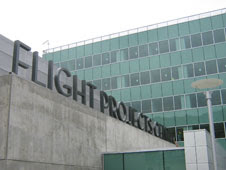JPL's 'Green' Space Flight Building Debuts with Ribbon-Cutting
 NASA's "greenest" building to date -- an environmentally friendly Flight Projects Center at NASA's Jet Propulsion Laboratory in Pasadena, Calif. -- is now open for business, following a ribbon-cutting ceremony today attended by lawmakers and local dignitaries.
NASA's "greenest" building to date -- an environmentally friendly Flight Projects Center at NASA's Jet Propulsion Laboratory in Pasadena, Calif. -- is now open for business, following a ribbon-cutting ceremony today attended by lawmakers and local dignitaries.The building houses missions during their design and development phases. It will enable engineers and scientists from various countries to collaborate more closely during these critical mission phases.
"It seems fitting that the new building, where teams will plan future space missions that use new technologies, also has the latest 'green' technologies to help JPL do its part to improve our environment here on Earth," said JPL Director Charles Elachi, who helped cut the ribbon at today's ceremony.
Also attending today's ceremony were U.S. Rep. David Drier; La Canada-Flintridge Mayor Laura Olhasso; staff representing U.S. Rep. Adam Schiff; and Caltech President Jean-Lou Chameau.
 The building has received the "LEED Gold Certification" under the Leadership in Energy and Environmental Design rating system, set up by the non-profit U.S. Green Building Council. It is the first NASA building to achieve that certification. To qualify, buildings must meet several criteria. For example, they must make efficient use of water, energy and resources, and provide a healthy and comfortable indoor workspace.
The building has received the "LEED Gold Certification" under the Leadership in Energy and Environmental Design rating system, set up by the non-profit U.S. Green Building Council. It is the first NASA building to achieve that certification. To qualify, buildings must meet several criteria. For example, they must make efficient use of water, energy and resources, and provide a healthy and comfortable indoor workspace.The many "green" features of the new building include:
- A living roof to keep the building cool in summer months and warm in the winter. Desert plants on the roof and other landscaping require 72 percent less water than a typical Southern California landscape design.
- Outdoor lighting is used for safety purposes only and is directed toward the ground, reducing the amount of light pollution that escapes to the night sky.
- Low-flow faucets and toilets reduce water use by 40 percent compared with typical fixtures.
- Improved wall insulation, efficient chillers and boilers and window shading devices.
- The paints and other surface materials have low levels of toxic fumes.
- The heating and cooling system is "smart" -- it knows whether people are in a room and adjusts the temperature and ventilation accordingly.
- The janitorial staff uses green cleaning products and practices.
More than 75 percent of the waste generated during construction of the new building was diverted from a landfill to a local recycling facility. Wood was acquired from Forest Stewardship Council-certified suppliers, ensuring sustainable harvesting of trees.
More information about the Leadership in Energy and Environmental Design rating system and the U.S. Green Building Council is online at http://www.usgbc.org .
More information about JPL is online at http://www.jpl.nasa.gov . The California Institute of Technology in Pasadena manages JPL for NASA.
More information about the Leadership in Energy and Environmental Design rating system and the U.S. Green Building Council is online at http://www.usgbc.org .
More information about JPL is online at http://www.jpl.nasa.gov . The California Institute of Technology in Pasadena manages JPL for NASA.



 12:27 AM
12:27 AM
 sheldon
,
sheldon
,















0 Response to "JPL's 'Green' Space Flight Building Debuts with Ribbon-Cutting"
Post a Comment